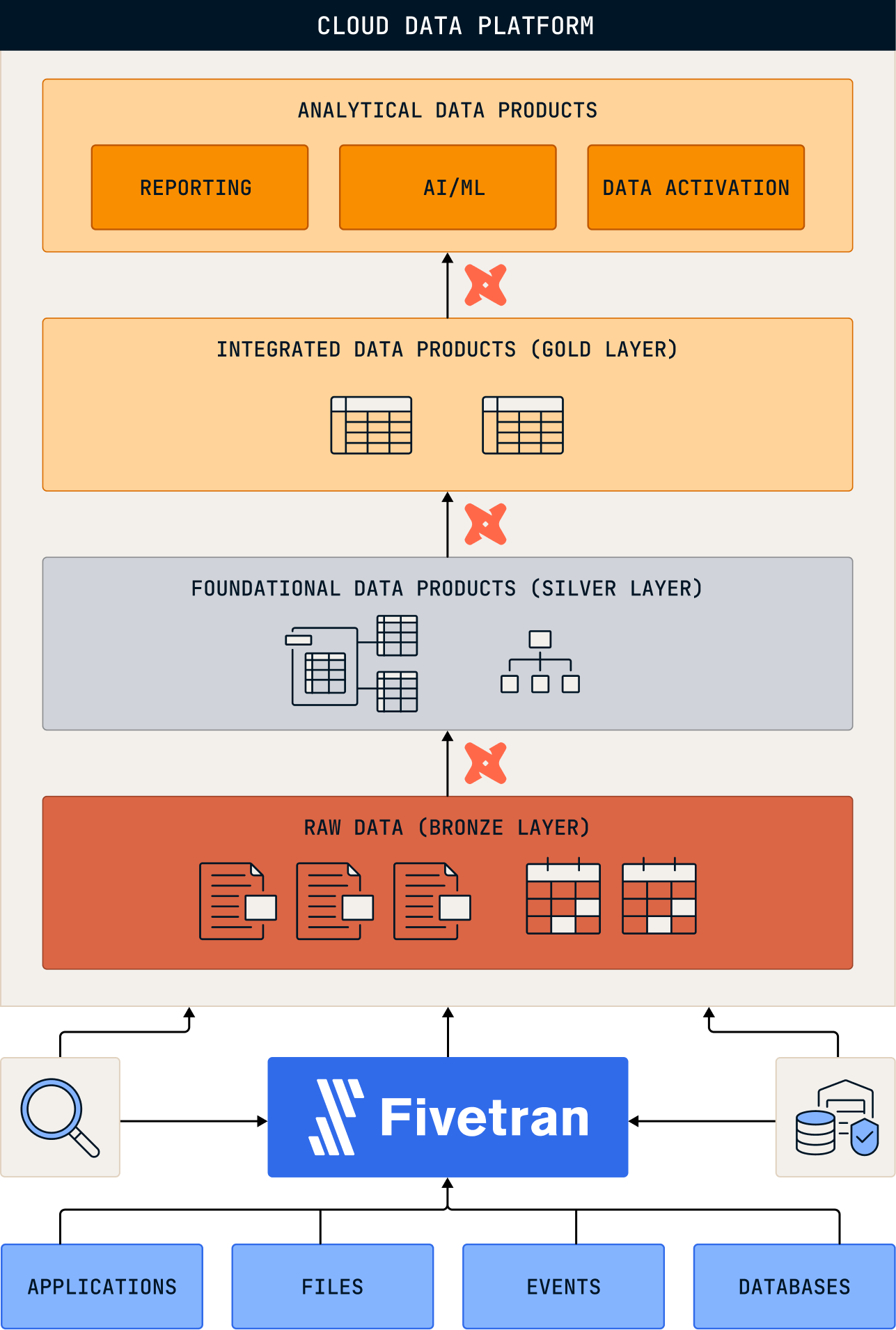In any data-driven organization, effective data management is crucial not only for unlocking insights but also for maintaining consistency and alignment across teams. Data products are central to this effort, playing key roles in maintaining data quality, governance, and usability. Data products consist of curated, actionable datasets and other assets that empower teams to derive insights, make decisions, and automate processes.
Without organizing data into discrete products, organizations often face data debt: unmanaged changes that create complex, fragmented data structures. This occurs when layers of ad hoc fixes produce convoluted SQL code and fragmented data silos, undermining the legibility and usefulness of the data.
Organizations need to ensure the quality and relevance of their data as they scale and increasingly leverage AI. Data products remain crucial to maintaining oversight, ensuring that data pipelines meet expected standards and are free from unnecessary complexity. Moreover, treating data assets as products bridges communication gaps across teams and helps foster a data-driven culture where data is consistently managed, trusted, and aligned with business goals.
Fivetran supports this journey by automating data ingestion, supporting transformations, and enforcing governance across the data pipeline, helping organizations build scalable, governed data architectures and products.
What is a data product?
A data product is a curated, packaged dataset or other data services and data assets created to meet specific business needs. Data products are designed to be consumed by various teams or applications to derive insights, make decisions, or automate processes. They must be reusable and trusted.
An example of a data product is a customer 360 dataset that combines customer demographics, transaction history, and engagement metrics to provide a comprehensive view of customer behavior. Another example is a fraud detection model used to identify suspicious transactions.
Types of data products
Data products are categorized into three types: foundational, integrated, and analytical. Each of these is a step in a progression toward the next. The “foundational” and “integrated” types roughly correspond with the “silver” and “gold” stages in the medallion (bronze -> silver -> gold) architecture, respectively.

Foundational data products (aka silver layer)
Foundational data products serve as the source of truth within an organization, containing critical datasets such as customer, product, or transaction data. These products require high data quality, compliance, and consistency, as other data products are built from them.
Fivetran ensures the integrity and quality of foundational data through automated ingestion, transformation, and metadata tracking support. By supporting metadata logging and governance, Fivetran helps establish foundational data products as clean, trusted sources that serve as building blocks for more complex data products.
In the medallion architecture, this layer corresponds with the silver layer. It is not raw data, but lightly cleaned, transformed, and often normalized for legibility.
Integrated data products (aka gold layer)
Integrated data products are datasets optimized for specific business use cases (e.g., a Customer 360 view). These products require connecting records from different silos, robust transformation capabilities, and scalability to support diverse analytical needs.
Fivetran supports integrated data products by managing complex transformations through its integration with dbt or by integrating with third-party transformation tools (dbt Cloud and Coalesce) natively, enabling seamless data aggregation across domains.
In the medallion architecture, this layer corresponds with the gold layer – finished data models that directly power reports, dashboards, and AI/ML models.
Analytical data products
Analytical data products are end products sitting on top of the gold layer. They are used for insights, reporting, and decision-making. These include dashboards, predictive models, and ML-based solutions that rely on curated, high-quality data. Analytica data products must be reliable and accurate so that stakeholders can confidently use them to make decisions
Data products follow the same lifecycle as other products
Like all products, data products follow a lifecycle:
- Design and planning: Define the product's purpose, ownership, and quality standards. This includes setting service level agreements (SLAs), key performance indicators (KPIs), and governance rules, and by specifying inputs, outputs, and usage guidelines.
- Development and build: Build the data product by ingesting, transforming, and modeling the appropriate data. This stage involves adding necessary components like lineage, observability, and validation to ensure the data product's trustworthiness.
- Deployment and distribution: Publish the data product so it can be discovered and accessed, whether by internal or external users. You will also need to ensure proper access controls and documentation are in place.
- Monitoring: End-users consume the data product. During this phase, monitor its performance, quality, and adoption. Establish feedback loops to gather input from users.
- Iteration and evolution: Based on monitoring insights and user feedback, improve the data product. This can involve adding new features, attributes, or adapting to new business or compliance requirements.
- Sunsetting: When a data product is no longer needed or becomes outdated, it is retired gracefully. This process should involve proper communication and archiving or disposal to maintain an efficient data ecosystem.
Managing data products effectively requires lifecycle oversight, monitoring, and regular improvements. The lifecycle management of all data products depends heavily on data governance. Fivetran supports this need by ensuring that users can know, protect, and control access, i.e., to govern, their data.
Metadata management and data lineage
Fivetran's log events from the Fivetran Platform Connector provide granular visibility into data flows and transformations. In combination with a technical catalog like Polaris, this metadata tracking ensures that data lineage is fully traceable, giving data consumers and producers a clear view of the journey each data point takes from source to destination.
Role-based access control (RBAC)
Fivetran offers role-based access control to enforce data governance policies at multiple levels, ensuring that only authorized users can access sensitive data.
Tracking and monitoring usage and performance
Through its metadata and monitoring tools, Fivetran provides insights into data product usage and performance, helping teams assess the health and adoption of each data product.
In particular, this monitoring exposes key performance indicators for data products, such as active usage rates, data freshness, and quality scores, enabling organizations to track how data products contribute to business value.
Rationalizing data products
Fivetran’s comprehensive view of data flows allows organizations to identify and sunset redundant or overlapping data products, supporting efforts to consolidate and optimize the data product portfolio.
This helps prevent data product sprawl, allowing organizations to focus on maintaining high-quality, high-impact products rather than managing an overextended portfolio.
Enforcing data product governance
Fivetran enables governance by integrating with data cataloging tools and providing detailed metadata. These capabilities ensure data products remain governed throughout their lifecycle, adhering to data quality and compliance standards.
With Fivetran, data teams can maintain a clear ownership structure, enforce accountability, and conduct regular reviews of data products to ensure continued alignment with business goals over the lifecycle of a data product.
Use data contracts to mediate everything about data products
Many organizations further strengthen their data operations through the use of data contracts, which serve as formal agreements between data producers (teams responsible for generating or managing data) and data consumers (teams that analyze or use the data). These contracts define expectations around data quality, schema consistency, transformation logic, and delivery schedules. By setting clear standards of accountability and preventing unintended changes to critical datasets, data contracts create a reliable foundation on which data products can be built, maintained, and used. This alignment ensures that data products remain trustworthy and actionable, fostering collaboration and reducing friction between engineering and analytics teams.

Conclusion
By automating data ingestion, supporting transformations, supply metadata for auditing and lineage tracking, and enforcing access controls, Fivetran ensures that the full spectrum of data products remains high-quality, compliant, and aligned with organizational standards. This alignment fosters a scalable, governed data ecosystem where data products—from foundational to analytical—can reliably support business objectives and insights.
With Fivetran’s comprehensive capabilities, organizations can effectively manage data product lifecycles, driving sustained value from their data assets as they scale.
[CTA_MODULE]

.png)











